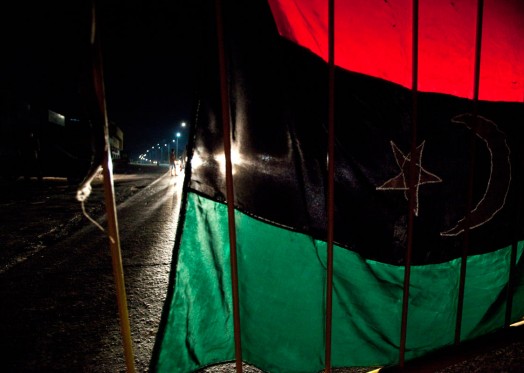Back from Libya
September 5, 2011

There was no light in the house where I stayed in Tripoli during the fight, so I couldn't run my blog. The generator was an old gear providing just enough power to charge our batteries (laptops, cameras, sat phones, BGan) and the fuel on the black market was hard to find, so we had to minimize the use of it. Now back home I briefly sum up.
I crossed the Libyan border at Dhima on Tuesday morning, August 23, with Gabriella, her cameraman Elia and Elisabetta Piqué of the Argentinian daily La Naciòn. We took a ride on a rebels' 4x4 to Nalut on the Jebel Nafusa where we managed to hire a car and hit the road to Tripoli. All shops closed for Ramadhan, no food all day. Imad, the driver, himself a Berber from the Jebel, had sized the car from the local police during the uprising: a big sturdy jeep with no plate and plenty of space for us all. We headed down towards the plain: yellow landscapes and barren mountains, clear sky, very hot. I spoke in Arabic with Imad. He told me the road was quite safe up to Zawiya, where we had planned to spend the night.
We passed deserted villages, left behind destroyed buildings, damaged mosques, abandoned fields. A few charred tanks laid among the ruins of what appeared a military outpost hit by Nato planes. At a check point we were told by rebel fighters that half of Tripoli was in their hands, so we changed our plan and headed straight to the city. Imad took us to a western neighbourhood where some of his relatives live and we were lucky to meet Hadia Gana, a smart cultivated and friendly revolutionary activist and art teacher (I wrote her story for Vanity Fair, with pictures taken by Ron Haviv): she invited us to stay in her house. The light was on and off, mostly off, but we had water and her nephews Ahmed and Yusuf could drive us in their cars (Imad had no papers for his stolen jeep and wasn't keen to use it in town..).
The rebels had just begun the final assault on Bab al-Aziziya, the huge fortified Gheddafi compound in the middle of the capital. We went there. The battle was raging. A towering cloud of black smoke hanged all over the place. Buildings were burning, the famous Coronel's tent turned to ashes. We followed the fighters inside the compound and I wished I had a bullet-proof vest: the guys on our side were firing rockets, Rpgs, rounds after rounds of light and heavy ammunitions as they slowly advanced towards the inner circle of the stronghold. It went on well after sunset, when we decided to go home: we had to set up the Bgan and file our stuff (written reports, videos and pics). We were exhausted: had not eaten nor slept for almost two days.
Early next morning we were back in Bab al-Aziziya. The rebels had just taken the main central building, partly destroyed, and were busy trying to tear down the symbolic monument in front of it: an iron fist crushing an american warplane, built after Ronald Reagan's failed attempt to kill Gheddafi in 1986. But there was still fighting in the southern part of the compound. Snipers were firing from different locations as I pulled myself crouching on my knees behind a concrete piece of wall from where I could see the green flags of the last resisting elite forces of the crumbling Gheddafi regime. Three dead bodies were lying in a pool of blood, one badly disfigured. There was a stand off. The rebels brought in heavy weaponry, rockets, machine guns. They fired straight on a bunker-like building some 400 metres down the street. Than, suddenly, at mid afternoon it was over. The Gheddafi soldiers had probably fled through one of the dozens underground tunnels.
For the next couple of days the fighting was confined to a few areas in the capital, mainly the airport and the Abu Salim district. But the battle of Tripoli was rapidly coming to an end as the city fell into the hands of the rebels. The town was still a dangerous place to roam. There were snipers on the rooftops, unexploded devices on the sidewalks and in the rubbles of the houses. And dead bodies rotting in the summer heat. I went to see the morgue at the Tobbi hospital: it was overwhelmed, and new bodies were taken in constantly in car trunks and trucks. We found other bodies scattered in the street of Abu Salim: some appeared to be civilians. A field hospital and some tents set up by pro Gheddafi activists against the Nato raids were razed to the ground, the corpses still there. Again I smell the stench of war: rotten bodies, hot metal, burning plastic...
There were celebrations at night in the former Green Square, renamed Maidan ash-Shuhada, Martyrs' Square. Shops were still closed and water was scarce but slowly the people started to dare the streets. Journalists were pouring in at the Corinthia Hotel: most of them never set a foot out in the field, but never forgot to wear a bullet proof vest and a helmet standing in front of the cameras on the hotel's veranda. The end of Ramadhan was getting closer. Bread was finally available in the morning, though the lines were long. Even longer were the lines at the few reopened gas stations: drivers had to wait two or three days to reach the pump.
Each day we left Hadia's house in search of news and stories to report: interviews with former Gheddafi soldiers, an 18 years sniper girl, the 53 charred bodies found in a warehouse next to the barracks of the 32nd Khamis Brigade, the prisons, the tortured, the underground tunnels, Gheddafi family's homes and seaside villas, the stranded african migrants, the raped women, the ammunition depots, the bombed Mukhabarat (secret service) headquarter where thousands of documents were left behind: in the top secret files found by Al Jazeera and Human Rights Watch the Cia and the MI6 are clearly involved in the activities of the Coronel's intelligence. By the way, this does't come as a surprise. As the finding of Israeli weapons in the hands of Gheddafi's mercenaries.
There was not an unified rebel command in Tripoli: the Transitional Council was still sitting in Benghazi, although some delegates had arrived at the Corinthia, and the thowar (revolutionary forces) had settled in different areas of the city, each group claiming to be in control of its own sector and manning the check points in a wild and joyful way, firing constantly in the air and chanting revolutionary songs. Quite soon the bulk of the rebels left the town, handing the check points to the local guys. They rushed towards Gheddafi's last strongholds in Bani Walid and Sirte, and we went along, stopping on our way to catch a glimpse of the ancient roman city of Leptis Magna (impressive, marvelous ruins on the Mediterranean coast: as the only visitors, we wondered in perfect solitude through theatres and temples untouched by the fighting).
Misurata, halfway between Tripoli and Sirte, some 200 km east of the capital, was severely damaged during the longest battle so far. Its fearless fighters, reputedly the bravest on the field, well equipped and disciplined, played a decisive role in crushing Gheddafi's forces in Tripoli and were now posed to attack in Sirte and Bani Walid where rumors hinted to the presence of Gheddafi's son Saif al-Islam. They lost hundreds in the bloodshed for Misurata: their names are written on a long white martyrs' wall in the city center. Tripoli Street had been the frontline for months: it looked like Grozny or Beiruth during the civil war, with demolished buildings, burned shops, empty houses, broken guns, charred tanks, shrapnels, minarets sprayed with bullets. And people lost in the rubble.
We spent the night on the floor of a vacant apartment and the following day we reached the last check point on the road to Sirte. We chatted with the fighters: they were waiting orders to advance, as they were the rebels at the check point near Bani Walid. Negotiations were on the way for a peaceful surrender. No one wanted to shed more blood. We drove back to Tripoli and got trapped in a traffic jam: a huge celebration for the victory of the Libyan soccer team vs. Zimbabwe in Cairo. Lights on in the streets, boys and girls weaving flags, dancing, cursing the hated dictator, finally showing their relief for the end of fighting, the end of the terror. For us, it was time to go. The story was dying. Politicians were taking over the stage. Gheddafi's second wife Safiya and sons Aisha, Hannibal and Mohammed had fled to Algeria. Gheddafi himself was likely hiding somewhere in the Sahara sands, but was finished anyway. France, the UK and Italy promptly announced the unfreezing of Libyan funds in their banks and started to airlift cash to the new government: the rush to the oil fields and to the spoils of the Jamahiriya had begun. So we cross the Tunisian border and flew home.





